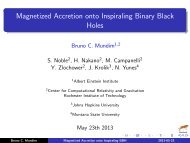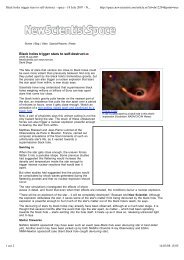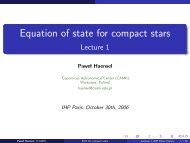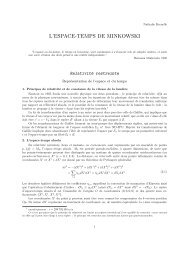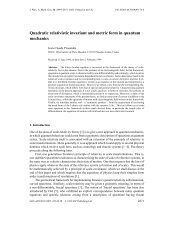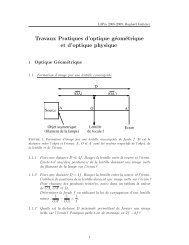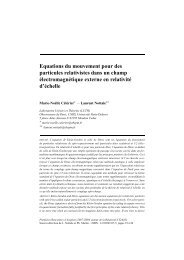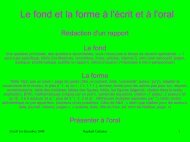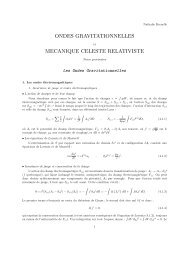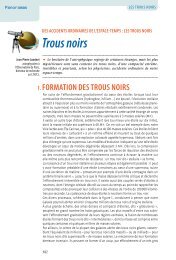Gravitational waves from core collapse supernovae - LUTh
Gravitational waves from core collapse supernovae - LUTh
Gravitational waves from core collapse supernovae - LUTh
Create successful ePaper yourself
Turn your PDF publications into a flip-book with our unique Google optimized e-Paper software.
<strong>Gravitational</strong> <strong>waves</strong> <strong>from</strong><br />
<strong>core</strong> <strong>collapse</strong> <strong>supernovae</strong><br />
Ewald Müller<br />
Max-Planck Institut für Astrophysik
<strong>Gravitational</strong> <strong>waves</strong><br />
(Einstein quadrupole formula)<br />
h jk = 2G<br />
c 4<br />
time-dependent mass-energy quadrupole moment<br />
in <strong>core</strong> <strong>collapse</strong> <strong>supernovae</strong> due to<br />
- convection in proto-neutron star<br />
- convection in neutrino heated hot bubble<br />
- anisotropic neutrino emission<br />
- any other non-radial instability (e.g. SASI, AAC)<br />
1<br />
R<br />
and due to rotation and magnetic fields<br />
d 2 Q jk<br />
dt 2<br />
~ R s<br />
R<br />
•<br />
-20 *<br />
R =1 km , v/c=0.1 , R=10kpc ---> h ~ 10 s<br />
generically produced by any CCSN<br />
* [ measuring the distance earth-sun with an accuracy of 1 nm ]<br />
v 2<br />
c 2
●<br />
●<br />
● An<br />
●<br />
important<br />
technical<br />
aspect !
●<br />
●<br />
● Stability<br />
●<br />
against pseudo<br />
radial modes (<strong>collapse</strong>)<br />
of self-gravitating<br />
rotating configurations
●<br />
●<br />
The effective adiabatic index
●<br />
●<br />
●<br />
● A<br />
● of<br />
●<br />
● the<br />
●<br />
● of<br />
brief history<br />
the efforts to predict<br />
GW signature<br />
<strong>core</strong> <strong>collapse</strong> <strong>supernovae</strong>
Most studies aimed at studying the GW signature of <strong>core</strong> <strong>collapse</strong><br />
<strong>supernovae</strong> based on greatly simplified parameterized models<br />
* spheroidal / ellipsoidal, one-zone models<br />
(Saenz & Shapiro '81) �E/Mc 2 ~ 10 -6 ... 10 -4<br />
* Newtonian ''realistic'' prompt explosion models, parameterized<br />
non-equilibrium progenitor models<br />
(Müller '82, Mönchmeyer etal '89) �E/Mc 2 ~ 10 -10 ... 10 -7<br />
* Newtonian polytropes, parameter study of non-equilibrium<br />
progenitor models<br />
(Finn & Evans '90, Yamada & Sato '95, Zwerger & Müller '87,<br />
Rampp, Müller & Ruffert '98 (3D) )
●<br />
1<br />
Collapse dynamics & waveform types in rotational <strong>core</strong> <strong>collapse</strong><br />
(Newtonian gravity, axisymmetric models)<br />
● Mönchmeyer et al., '91: 4 models with tabulated EOS<br />
●<br />
●<br />
● typical signal<br />
strength &<br />
frequency:<br />
● h ~ 10 -20<br />
at 10 kpc<br />
● f ~ 500Hz -<br />
1 kHz<br />
●<br />
●<br />
● Zwerger & Müller '97: 78 models with simple analytic EOS
* GR <strong>collapse</strong>(CFC), parameter study of equilibrium progenitor<br />
models, simplified equation of state, no transport<br />
(Dimmelmeier, Font & Müller '02 ; Shibata '03)<br />
* microphysical equation of state, Newtonian gravity, some<br />
treatment of weak interactions and crude neutrino ''transport''<br />
(Fryer, Holz & Hughes '02, '04 ; Fryer etal '03 ;<br />
Kotake, Yamada & Sato '03 ; Ott etal '03)<br />
* simple equation of state, Newtonian gravity, MHD models<br />
(Kotake etal '04 ; Yamada & Sawai '04 ; Obergaulinger etal '04)<br />
---> �E GW < 10 -6 M sun c 2
•<br />
•<br />
• GR <strong>collapse</strong> of rotating polytropes using CFC approximation<br />
1<br />
(H. Dimmelmeier, J.A. Font & EM '02, '03)<br />
• toroidal density stratification at bounce for an increasing rate and<br />
degree of differential rotation
Rotational <strong>core</strong> bounce can occur at subnuclear densities!<br />
<strong>Gravitational</strong> <strong>waves</strong> provide direct diagnostic tool<br />
c e n tra l d e n s ity<br />
w a ve a m p litu d e<br />
bounce due to the stiffening of the equation<br />
of state beyond nuclear matter density<br />
c e n tra l d e n s ity<br />
w a ve a m p litu d e<br />
multiple bounce due to rotation<br />
GRHD simulations of polytropes (Dimmelmeier, Font & Müller 2002)
●<br />
● ---><br />
●<br />
●<br />
●<br />
●<br />
●<br />
●<br />
●<br />
●<br />
●<br />
● source<br />
GW amplitude vs frequency for GR and Newtonian models<br />
(Dimmelmeier, Font & Müller '02)<br />
centrifugal bounce less likely to occur in GR<br />
at 10 kpc
* presently most advanced microphysical study (concerning<br />
the GW signature of <strong>core</strong> <strong>collapse</strong> <strong>supernovae</strong>)<br />
(Müller, Rampp, Buras, Janka & Shoemaker '04)<br />
- microphysical equation of state<br />
- progenitor models <strong>from</strong> stellar evolutionary calculations<br />
- detailed modelling of all relevant weak interaction processes<br />
- multi-flavour Boltzmann neutrino transport<br />
- effective relativistic gravitational potential<br />
- Newtonian dynamics of axisymmetric flows
GWs <strong>from</strong> a non-rotating 11.2 M sol star<br />
Models with detailed micro and transport physics<br />
Müller, Rampp, Buras, Janka & Shoemaker '04
GWs <strong>from</strong> a rotating 15 M sol star<br />
b o u n c e s ig n a l<br />
Müller, Rampp, Buras, Janka & Shoemaker '04
GWs <strong>from</strong> simplified models of CCSNe:<br />
- miss important physics (convection)<br />
- initial models rotate too fast according to state-of-the-art<br />
stellar evolution models and spin rates of young pulsars<br />
GWs <strong>from</strong> elaborate models of CCSNe: LIGO II<br />
- proto-neutron star convection (at least): ~ 10 kpc<br />
- convection in non-rotating progenitors: ~ 15 kpc<br />
both type of signals are generically produced by any CCSN<br />
- state-of-the-art rotating progenitors: ~ 100 kpc<br />
[ only bounce signal: ~ 5kpc ]
●<br />
●<br />
● Towards<br />
●<br />
● relativistic<br />
<strong>core</strong> <strong>collapse</strong> simulations<br />
● with<br />
● detailed<br />
microphysics<br />
● &<br />
● neutrino<br />
transport
●<br />
1
●<br />
1
●<br />
1
●<br />
1
●<br />
1
●<br />
1
●<br />
1
●<br />
1
●<br />
● most sophisticated simulations of GR rotational <strong>core</strong> <strong>collapse</strong><br />
●<br />
1<br />
up to now include: (Ott, Dimmelmeier, et al., 06)<br />
● - coupled relativistic gravity (BSSN, CFC) and GRHD<br />
(Cactus/Carpet/Whisky & CoCoNut codes)<br />
● - tabulated microphysical EOS (Shen et al., '98; Marek et al., '05)<br />
● - Newtonian quadrupole formula for GW signal<br />
●<br />
● - parameterized, approximate<br />
treatment of deleptonization<br />
(Liebendörfer '05: 1D!!)<br />
● Y e ~ ρ and ρ trap<br />
fine until shortly after bounce!
●<br />
1<br />
Simple vs. microphysical EOS (Ott, Dimmelmeier, et al., 06)<br />
● slow & (almost) uniform rotating progenitor („best“ stellar evolution)<br />
●<br />
●<br />
●<br />
●<br />
●<br />
●<br />
●<br />
●<br />
●<br />
● simulations with microphysical EOS:<br />
- influence of rotation on dynamics & GW signal less pronounced<br />
● - no longer multiple centrifugal bounces & type-II GW signals<br />
(for very rapid rotators: type-I <strong>collapse</strong> dynamics & GW signal)
●<br />
1<br />
Detection prospects of GW <strong>from</strong> <strong>core</strong> <strong>collapse</strong> (to NS)<br />
● - bounce signal of a galactic supernova detectable by current detectors<br />
● - microphysical EOS: GW signal frequency range significantly narrower<br />
●<br />
●<br />
● low frequency<br />
GW signals<br />
(i.e. multiple<br />
centrifugal<br />
bounces)<br />
are suppressed<br />
in simulations<br />
with GR &<br />
a microphysical<br />
EOS!<br />
● (Ott, Dimmelmeier,<br />
et al., 06)
●<br />
1<br />
Cause of suppression: relativistic gravity?<br />
● Newtonian study of the <strong>collapse</strong> of rotating polytropes (Zwerger & Mueller, '97)<br />
repeated in relativistic gravity<br />
(Dimmelmeier, Font & Muller, '02; Dimmelmeier et al., 05; Cerda et al., '05;<br />
Shibata & Segikuchi, '05, '06)<br />
● relativistics effects: deeper potential --> larger bounce densities, more<br />
compact PNS<br />
● less multiple centrifugal bounces (less type II GW signals)
●<br />
1<br />
Cause of suppression: microphysical EOS?<br />
● - neglect deleptonization and adopt adiabatic index for simplified<br />
EOS according to microscopic EOS<br />
● - simple EOS (piecewise polytropic + thermal part to mimic shocks)<br />
● γ < 4/3 for ρ < ρ nuc = 2 10 14 g/cm 3<br />
● γ = 2.5 for ρ > ρ nuc<br />
● similar to microphysical EOS<br />
●<br />
● - centrifugal bounce: (below ρ nuc )<br />
●<br />
γ is always very close to 4/3<br />
● ---> approximating microphysical EOS with simple EOS (with γ=1.32)<br />
predicts correct <strong>collapse</strong> & GW signal type!
●<br />
1<br />
Cause of suppression: deleptonization?<br />
● - when including effects of deleptonization: no centrifugal multiple<br />
bounce found! (neither in Newtonian nor relativistic gravity)<br />
(Dimmelmeier et al., in prep.)<br />
●<br />
●<br />
●<br />
●<br />
●<br />
●<br />
●<br />
●<br />
●
1<br />
Conclusions<br />
Relativistic gravity important for explosion mechanism & GW signal<br />
Its effects can be well modelled (for not too extreme models) by<br />
means of an effective relativistic potential (during <strong>collapse</strong> to NS)<br />
Models of (rotational) <strong>core</strong> <strong>collapse</strong> including a microphysical EOS,<br />
some treatment of the <strong>core</strong>'s deleptonization, and (approximate)<br />
relativistic gravity show no multiple centrifugal bounce<br />
Open questions: GR post-bounce evolution & GW signal<br />
GR & magnetic fields (collapsars)<br />
BH formation <strong>from</strong> <strong>core</strong> <strong>collapse</strong>
●<br />
● Additional<br />
aspects<br />
3D effects (angular momentum conservation during <strong>collapse</strong>)<br />
fast rotating<br />
axisymmetric<br />
<strong>core</strong>s may<br />
become triaxial<br />
but<br />
low density at<br />
bounce<br />
rotating polytropes (Rampp, Ruffert & Muller '97)
●<br />
● Additional<br />
● (Bazan<br />
aspects<br />
asymmetries (��/� ~ 10%) in progenitor star due to oxygen &<br />
silicon burning<br />
4 s -1<br />
& Arnett '98)<br />
0.25 s -1<br />
h = ~ 20% of amplitude of fast rotating <strong>core</strong> (Fryer, Holz & Hughes '04)<br />
10 s -1<br />
0 s -1
●<br />
●<br />
●<br />
●<br />
● Relativistic<br />
● An<br />
<strong>core</strong> <strong>collapse</strong> simulations:<br />
alternative approach
•<br />
•<br />
Characteristic GR <strong>collapse</strong> of axisymmetric polytropes<br />
Initial value problem of general relativity: Choice of foliation?<br />
Cauchy/ADM<br />
(boundary conditions?)<br />
characteristic/light cone<br />
(unambigous extraction of GW)
•<br />
•<br />
1<br />
Application: Spherical and non-spherical <strong>core</strong> <strong>collapse</strong><br />
(Siebel et al., 02) [polytropes, hybrid EOS (bounce + shock)]<br />
Evolution of central density:<br />
Increase by 4.5 orders of magnitude<br />
spacetime<br />
diagram<br />
shock<br />
formation &<br />
propagation
•<br />
•<br />
<strong>Gravitational</strong> <strong>waves</strong> at null infinity: Bondi news function<br />
- gauge contributions must be considered<br />
- shock propagation creates numerical noise<br />
Work still in progress!<br />
first time characteristic<br />
2D numerical relativity<br />
is applied to a matter<br />
flow problem
Magnetohydrodynamic<br />
effects in supernova
●<br />
1<br />
Basic MHD processes in <strong>core</strong> <strong>collapse</strong><br />
(Meier, Epstein, Arnett & Schramm '76)<br />
● infall R≈R 0 /� � E G ≈�E G0 , E rot ≈� 2 E rot0 , E mag ≈ �E mag0<br />
(if <strong>collapse</strong> approx. homologous)<br />
● poloidal circulation (due to centrifugal force) � �(�)~� -2<br />
● linear field amplification (toroidal field) by differential rotation<br />
●<br />
●<br />
● Up to 2000 only a few<br />
numerical studies:<br />
● LeBlanc & Wilson ('70)<br />
Bisnovatyi-Kogan etal ('76)<br />
Müller & Hillebrandt ('79)<br />
Ohnishi ('83)<br />
Symbalisty ('84)<br />
●
●<br />
●<br />
1<br />
Meier, Epstein, Arnett & Schramm '76<br />
● two parameters determine<br />
evolution:<br />
● � R0 = E rot0 / E G0<br />
● and<br />
● � M0 = E mag0 / E G0<br />
●<br />
●<br />
● model C (LeBlanc & Wilson '70):<br />
● 7 M sun Fe-Ni <strong>core</strong><br />
● � R0 = 0.0025 ⇔ � = 0.42 rad/s<br />
� M0 = 0.00025 ⇔ B = 9.2 10 11 Gauss<br />
Heger etal '05: �=0.05s -1 , � R0 = 5x10 -4<br />
observed WD fields: � M0 < 10 -10
●<br />
1<br />
Other MHD processes<br />
● - Thompson & Murray ('01) field amplification and transport by rapid<br />
(semi-analytic) convective overturn in PNS for ~10 s ; if<br />
turbulent = magnetic stresses � B equi ~ 10 15 G<br />
● - Wheeler etal ('00, '02) asymmetric CCSNe & MHD jets (like in AGNs);<br />
(semi-analytic) field amplification by differential rotation<br />
and possibly by an �-� dynamo<br />
● - Akiyama etal ('03) importance of MRI (exponential growth ~� -1 )<br />
(1D HD) � strong MHD activity in PNS & behind<br />
stalled shock; even for moderate initial<br />
conditions: Bsat ~10 15 ...10 16 G ?<br />
● - Sato's group<br />
Yamada & Sawai ('04) parameter studies with polytropic & realistic<br />
Kotake etal ('04a, '04b) EOS; neutrino leakage scheme;<br />
Takiwaki etal ('04) field contribution to GW signal<br />
Kotake etal ('05)<br />
Sawai etal ('05) --> no MRI?<br />
(2D MHD)
●<br />
●<br />
●<br />
● Initial models:<br />
● - rigidly & diff. rotating<br />
polytropes (as in<br />
Zwerger & Müller '97)<br />
●<br />
1<br />
● - approx. rel. gravity<br />
●<br />
– 2D MHD simulations: Obergaulinger, Aloy & Müller 2005<br />
– (TVD MHD code of Pen, Arras & Wong 2003<br />
based on the relaxing TVD scheme of Jin & Xin 1995 )<br />
● - B-field <strong>from</strong> toroidal<br />
current loop in equat.<br />
plane (100≤r/km≤800)<br />
● central field strength<br />
10 10 – 10 13 Gauss<br />
(realist. B < 10 9 Gauss)
●<br />
●<br />
●<br />
●<br />
●<br />
●<br />
●<br />
●<br />
●<br />
1<br />
Evolution of central density and rotation rate:<br />
non-magnetized Newtonian initial model bouncing due to EOS<br />
(models A1B3G3-D3Mx, x∈ {10, 12, 13); Obergaulinger, Aloy & Müller '05)<br />
central density rotation rate<br />
● ----- 10 10 Gauss ----- 10 12 Gauss ----- 10 13 Gauss
●<br />
●<br />
●<br />
●<br />
●<br />
●<br />
●<br />
●<br />
●<br />
1<br />
Evolution of central density and rotation rate:<br />
non-magnetized Newtonian initial model bouncing due to rotation<br />
(models A3B3G3-D3Mx, x∈ {10, 12, 13); Obergaulinger, Aloy & Müller '05)<br />
central density rotation rate<br />
● ----- 10 10 Gauss ----- 10 12 Gauss ----- 10 13 Gauss
●<br />
●<br />
●<br />
●<br />
●<br />
●<br />
●<br />
●<br />
●<br />
●<br />
1<br />
<strong>Gravitational</strong> wave quadrupole amplitude:<br />
TOV (solid line) vs Newtonian (dashed line) models:<br />
(A1B3G3-D3M1x; Obergaulinger, Aloy & Müller '06)<br />
● 10 10 Gauss 10 13 Gauss
●<br />
●<br />
●<br />
●<br />
●<br />
●<br />
●<br />
●<br />
●<br />
●<br />
1<br />
<strong>Gravitational</strong> wave quadrupole amplitude:<br />
TOV (solid line) vs Newtonian (dashed line) models:<br />
(A3B3G3-D3M1x; Obergaulinger, Aloy & Müller '06)<br />
● ---- 10 10 Gauss ----- 10 13 Gauss
●<br />
●<br />
●<br />
●<br />
●<br />
●<br />
●<br />
●<br />
●<br />
1<br />
<strong>Gravitational</strong> wave spectra:<br />
(A3B3G3-D3M1x-T; Obergaulinger, Aloy & Müller '06)<br />
● ---- 10 10 Gauss ----- 10 13 Gauss<br />
●<br />
● enhancement of spectral power at low frequencies in strong<br />
field model (right) is due to collimated outflow (jet) !
●<br />
●<br />
●<br />
1<br />
Snapshot of model A3B3G5-D3M13 about 49 ms post-bounce<br />
strong initial B field & rapid rotation --> collimated outflow<br />
(Obergaulinger, Aloy & Müller<br />
'05)<br />
● gas & magnetic pressure<br />
●<br />
●<br />
●<br />
●<br />
● velocity & final velocity<br />
● (total energy --><br />
kinetic energy)
●<br />
● Conclusions <strong>from</strong> MHD studies up to now<br />
● - weak (realistic!) initial fields (B < 10 11 G) do neither change<br />
<strong>collapse</strong> dynamics nor resulting GW signal<br />
● - strong initial fields (B ≥ 10 12 G)<br />
---> - slow down <strong>core</strong> efficiently (even retrograde rotation occurs!)<br />
- qualitatively different dynamical evolution & GW signal<br />
- highly bipolar, mildly relativistic outflows<br />
● - shape of GW signal reflects dynamical behavior of the model<br />
(in particular the collimated outflow)<br />
●<br />
● Still waiting exploration: - MHD models with realistic microphysics<br />
and neutrino-driven convection<br />
● - secular evolution ?<br />
● - 3D effects, MHD instabilities (MRI) &<br />
possible MHD dynamo



